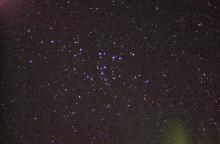Listen to today's episode of StarDate on the web the same day it airs in high-quality streaming audio without any extra ads or announcements. Choose a $8 one-month pass, or listen every day for a year for just $30.
You are here
Coma Galaxies
Gravity is a great organizer. It pulls things together to make them nice and neat. It pulls in gas to make stars. It pulls the stars together to make galaxies, galaxies to make galaxy clusters, and clusters to make superclusters.
One of the nearest superclusters is in the constellation Coma Berenices, which is high in the east at nightfall. The supercluster is centered about 300 million light-years away. It incorporates the galaxies of two clusters, known as Coma and Leo. Combined, they span about 20 million light-years.
Telescopes reveal that the clusters contain thousands of galaxies, each of which contains billions of stars. But no telescope can show us what makes up most of the mass of these galaxies — dark matter. It produces no detectable energy, but its gravity tugs at the visible matter around it.
Most dark matter is found outside the bright disks, balls, and blobs that make up the visible parts of galaxies. So in tightly packed clusters and superclusters, it mainly inhabits the dark regions between galaxies.
In fact, the existence of dark matter was first suspected in the Coma Cluster. In 1933, astronomer Fritz Zwicky found that the cluster’s galaxies were moving differently than they should be based on the gravity of their stars and gas. He proposed that some “dark matter” was altering their motion. It took decades to confirm the existence of dark matter — the “glue” that holds together vast collections of galaxies.
Script by Damond Benningfield




